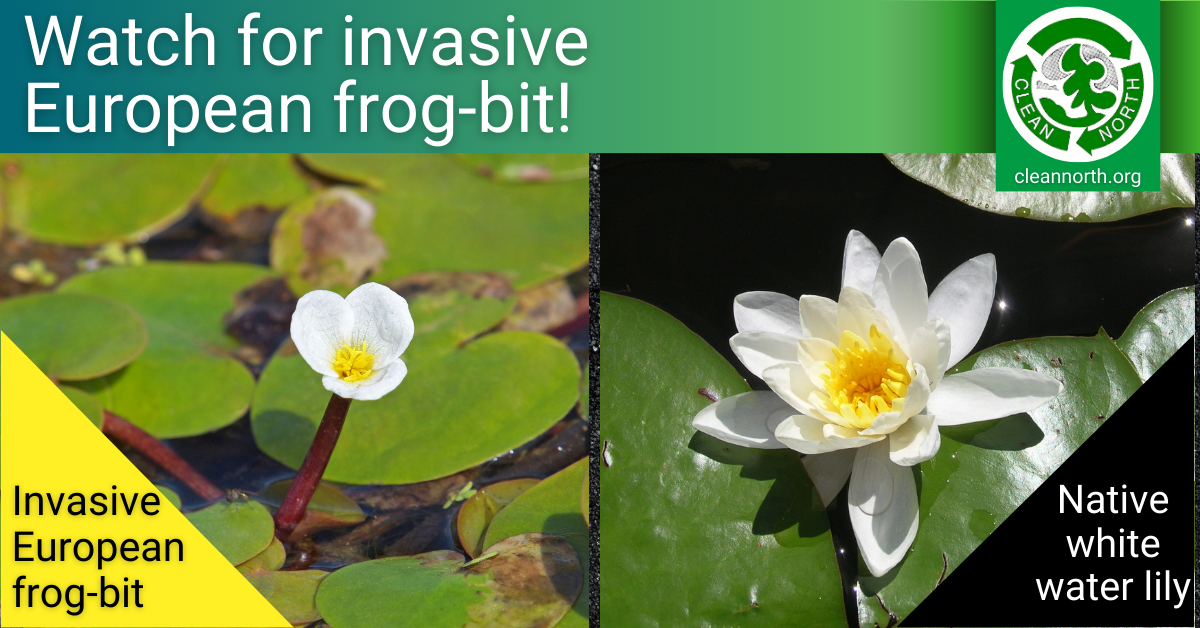
By guest writer Emma Jones*
European frog-bit (Hydrocharis morsus-ranae) is a damaging invasive aquatic plant that was introduced as an ornamental. It has caused many environmental issues and impacted native species. While it is often mistaken for American white waterlily (Nymphaea odorata), European frog-bit could not be more different. Since its introduction to North American in the 1930s, this species has continued to invade Ontario’s landscape and dominate ecosystems through outcompeting native plants.
This species poses many challenges as it impacts the environment, recreation, and farming. To limit the spread in northern Ontario, here’s what you need to know.
How to identify European frog-bit
Both European frog-bit and white water lily are commonly found in slower moving, protected, and shallow bodies of water, mainly ponds and rivers.
While the two species do look similar, there are some distinctions that can help you tell them apart. The easiest way is by their flowers: European Frog-bit grows smaller flowers with three small, heart-shaped petals, while white water lily grows much larger white flowers that are 15 cm across with long pointed petals.
The two species are distinguishable through leaf size as well. European frog-bit’s leaves are around 6 cm wide, whereas water lily’s leaves range from 15 to 30 cm wide.
What makes European frog-bit invasive?
The species is invasive because it spreads very fast, is difficult to control, and outcompetes native species. It was first introduced to Ottawa’s Botanical Gardens and later escaped and began to invade Rideau Canal.
This species spreads so densely in some areas that it leaves no room for other species to grow or receive sunlight.
Other environmental consequences of European frog-bit
- The invasiveness of European frog-bit causes a lack of diversity in ecosystems. Biodiversity keeps an ecosystem stable and productive. Ecosystems are more effective at completing functions like water purification and maintaining soil nutrients when there is a wide range of native species. Also, plant and animal species become very dependent on each other in an ecosystem. When an invasive species rapidly removes the diversity of an area, various species are often negatively impacted.
- European frog-bit reduces dissolved oxygen in water, which results in loss of fish, water invertebrates, and native aquatic plants. Aquatic plants and animals need dissolved oxygen in the water to survive. Only the most tolerant species can survive, which are often invasives.
Economic and recreational consequences of European frog-bit
Economic
- Can clog canals and waterways, making it hard for shipping vessels to get through and resulting in expensive control projects
- Can clog irrigation systems, creating extra costs and headaches for farmers.
Recreational
- Can Interfere with people’s ability to navigate boats, kayaks, canoes, etc. through waterways because of the dense mats of plants it forms
- Can make an area of a lake or river difficult or unpleasant to swim in
- Can impact tourism through loss of key activities
How can you help slow its spread?
If you use any equipment in waterways where European frog-bit (or other invasives) is present, it is important that you clean your equipment/boats thoroughly before leaving one waterway or entering another.
Helpful links:
- Preventing aquatic invasive species – Government of Canada
- European frog bit (scroll down to What Can You Do?) – Invading Species Awareness Program
In addition, choose only native plants for water features like backyard ponds. Keep in mind that even if your pond is well away from a lake or river, heavy rain/flooding can wash invasive plants to new locations. Plus the next owners of your property may not know about invasive plants and may pass on your invasive species to others or dump them in nearby ponds, lakes or rivers.
“Can I remove it?”
If you wish to remove European frog-bit from waterways on/adjoining your property, there are rules around doing so, and the rules are different for federal vs. provincial waters. Be sure to read up before taking action:
- Remove invasive Plants – Ontario Government
- Apply to prevent, control or eradicate an aquatic invasive species – Government of Canada
Most of the time, provincial regulations apply. According to the Regulations prescribed in O. Reg.
239/13 under the Public Lands Act, a person may remove invasive aquatic plants such as European
frog-bit using mechanical means or by hand without a permit if they follow all rules for removing
aquatic invasive plants. These include In-Water Work Timing Window Guidelines established to protect fish from impacts during spawning, migration and other critical life stages.
If you can’t meet all rules or want to act outside of the timing window, you will need a work permit. Contact the local MNRF District Office.
Where can I learn more about European frog-bit?
- European frog-bit – Invasive Species Centre website
- European frog-bit – Ontario’s Invading Species Awareness Program
- Reported distribution of European frog-bit in Ontario
- Invasive European frogbit (Hydrocharis morsus-ranae L.) in North America: an updated review 2003–16 – Journal of Plant Ecology
*Emma Jones is a Sault Ste. Marie-based environmentalist who is passionate about climate change and conserving the environment. She enjoys hiking and mountain biking in her free time.




